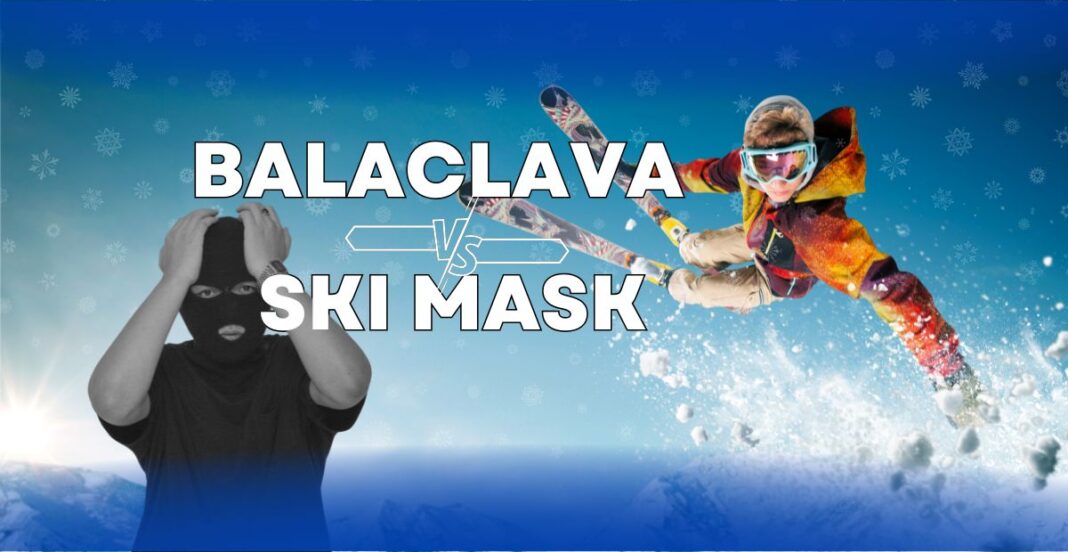Many individuals ask themselves whether the ski mask or the balaclava would keep someone warmer in cold weather conditions. Both accessories offer a degree of warmth and face protection; however, they have different functions. One’s choice of either ski mask or balaclava depends on weather, activity level, and personal preference. A ski mask leaves out the mouth and nose area, while a balaclava has flexible face opening. Considering the many common users of these two accessories, which one is better?
Table of contents
- Key Difference Between Ski Mask Vs. Balaclava?
- Ski Mask Versus Balaclava: Material and Craftsmanship Differences
- Ski Mask vs. Balaclava: Which Offers Better Cold Protection?
- Breathability and Comfort During Action Activities
- Ski Mask vs. Balaclava: Best for Outdoor Sports
- Ski Mask vs. Balaclava: Shield Against Wind and Snow
- Balaclava Vs. Ski Mask: Which Is More Versatile?
- Ski Mask vs. Balaclava: Protection Against Dust and Pollution
- Ski Mask vs. Balaclava: Best for Riders
- Balaclava Vs. Ski Mask: Restrictions and Rules
- Ski Mask vs. Balaclava: The More Appealing Option
- Conclusion: Making The Right Decision
- FAQs
Key Difference Between Ski Mask Vs. Balaclava?
The ski mask and balaclava seam to be similar in nature, however they differ both in their design and overall coverage.
Ski Mask: A term refers towards any mask that is worn on blanket style cover types used in ski sports, which can have portions open around the eyes, mouth, or both. They are generally meant to provide flexible and breathable features.
Balaclava: This term represents a type of mask that wraps around the full head, neck and face along with 360 degree coverings with adjustable eye and mouth openings. Such masks are, however, much warmer and are used during the winters to protect against wind.
To summarize everything above, ski masks are an umbrella term whereas a balaclava is a subset of skiing masks that provides full coverage.
Ski Mask Versus Balaclava: Material and Craftsmanship Differences
The primary difference between a ski mask and a balaclava is in the construction. A ski mask generally covers only the top half of the face, often leaving the mouth or nose exposed. A balaclava, on the other hand, covers the entire face and can be adjusted to different levels of exposure.
The choice of material also greatly impacts the performance. Fleece, wool, and synthetic blends are the most common materials, each having its distinct advantages. Fleece is warm and soft, therefore, very comfortable for long periods of time. Wool is a sweater fabric that is a great insulator and is moisture-wicking, meaning it will keep the skin dry and protected. Synthetic blends are flexible and provide durability, assuring long-term usage.
Ski Mask vs. Balaclava: Which Offers Better Cold Protection?
A colder climate requires taking appropriate precautions. Due to a ski mask exposing portions of the head, people are more likely to get frostbite in unforgiving temperatures. However, a balaclava ski mask offers full face coverage which is more appropriate in extremely cold situations. If warmth is what is needed the most a balaclava is the better option.
Frostbite is harmful and a balaclava keeps the entire head, neck and face warm. Cold strong winds and heavy snowfall also require additional protection from all angles. This mask can also be worn under helmets, which makes it also suitable for bikers, snowboarders and skiers. While a ski mask can also retain warmth, it does not cover as much as a balaclava does.
Breathability and Comfort During Action Activities
Moisture build up is to be avoided during outdoor activities, which makes ski masks better than balaclavas in that regard. A ski mask restricts airflow and a the balaclava may use materials which lack breathability and thus create moisture. Given the amount of effort and movement one does, personal tactile comfort plays a factor in the choice.
During strenuous exercises, such as running or cycling, a ski mask may be more suitable since it allows a portion of your face to remain uncovered and enables air to flow, thus averting overheating. On the other hand, a balaclava is best suited for low-intensity exercises in colder temperatures, where there is more need for heat retention than ventilation.
Ski Mask vs. Balaclava: Best for Outdoor Sports
Outdoor enthusiasts often debate “Ski Mask versus Balaclava, which is better for sports?” Ski masks are ideal for activities that require plenty of sight such as snowboarding. Balaclavas, on the other hand, retain more body heat as well as wind, making them good for skiing and hiking in greatly cold weather.
Both alternatives are frequently applied for skiing and other winter activities. Breathe masks have an open face style while ski masks are facial and sight concealing. The latter enables the athlete to see while exhaling and inhaling. Balaclava, however, is warmer because it insulates the face and protects it from icy temperatures. As a result, these two garments are useful depending on the sport type and climate.
Ski Mask vs. Balaclava: Shield Against Wind and Snow
Strong winds or snow need a garment that can be depended on. A balaclava protects the entire face and neck which serves as a shield from windburn and frostbite. Mask style ski wear can allow access of wind due to the cut-out sections. To protect the weather, a balaclava is the best choice since it is not a ski mask.
When there is snowfall, a balaclava helps block the snow from hitting the face since it offers complete coverage. Ski masks help but will not allow a face to be fully concealed making them ineffective in great weather. For outdoor workers, balaclavas are best suited as they will provide complete coverage.
Balaclava Vs. Ski Mask: Which Is More Versatile?
Choosing between a ski mask and a balaclava boils down to adaptability, and in this case, the ski mask comes up short. The multitude of ways in which a ski mask can be worn make it more adaptable to differing situations, whereas a ski mask is comparatively rigid. In this context, the balaclava wins with ease.
In addition, a balaclava can be worn as a neck gaiter which allows it to serve even further. Such versatility makes it easier to adjust to weather changes, especially for adventurous users.
Ski Mask vs. Balaclava: Protection Against Dust and Pollution
Aside from the usage of these accessories in cold weather, they can further serve as protection against dust and pollution. A ski mask user is partially protected however, a balaclava offers fullface coverage and thus more protection. A ski mask does not offer adequate coverage therefore, a balaclava is preferable for metropolitan settings.
In city traffic, cyclsists and motorcyclists commonly don a balaclava to offer protection against pollution and dust. Serving as a filter, it keeps harmful particles from entering the mouth and nose. While a ski mask is better in some regards, a balaclava offers a much greater level of protection for urban travelers.
Ski Mask vs. Balaclava: Best for Riders
For motorcyclists, wind, dust, and cold are all huge factors to overcome as riding becomes very uncomfortable. While facing these harsh conditions, a balaclava stands out by providing full coverage for the neck and face. A ski mask, open face design, is not suitable for riding due to the gaping hole in the front. For motercyclist who ride a lot, balaclavas are the best option.
Balacalavas work especially well under helmets, becoming a preferred option for motorcyclists. The suit bladder windburn, skin drying out, and modestly protect the neck and face from the most harsh of elements. Ski masks do cover these harsh elements, and I can’t deny they are very comfortable, I just feel that they are less useful for high speed riding.
Balaclava Vs. Ski Mask: Restrictions and Rules
A lot of places have restrictions and security concerns so ski masks are more acceptable in public spaces. A balaclava offers more face protection but can be seen as suspicious depending on the situation and location. Always keep in mind the local laws and restrictions before and deciding which mask is best to wear.
Ski Mask vs. Balaclava: The More Appealing Option
Ski masks offer a bit more style in their fun designs and colors which is more appealing. Balaclavas are very practical, but don’t focus on fashion, unlike Ski masks who want to appeal to the fashion conscience crowd. If fashion is something you are looking for, then a ski mask is the choice to make.
Conclusion: Making The Right Decision
The decision involving a ski mask or a balaclava falls into an individual’s preferences. A balaclava is superior in terms of covering the cold, wind, and dust. A ski mask is to be preferred for aesthetics, cost-effectiveness, and ease of breathing. Evaluating one’s personal preferences will assist in making the optimum selection.
FAQs
A balaclava provides better protection in extreme cold due to its full-face coverage.
Yes, both can be worn under a helmet, but a balaclava offers better coverage and warmth.
Laws vary by location, so check local regulations before wearing a balaclava in public.



Interesting point about the breathability of ski masks for active sports. I think that’s one of the most underrated features—being able to keep your face covered without feeling like you’re suffocating makes a huge difference during a long day in the snow.
Great point about how a ski mask can leave your face exposed in harsh conditions, but the balaclava keeps everything covered. I’d imagine in windy or snowy conditions, the balaclava is a clear winner. Thanks for this helpful comparison!
I liked how the article broke down the functional differences. I’ve always thought they were pretty interchangeable, but now I realize a balaclava might be better for high-intensity activities since it offers more flexibility and breathability.
This helped clarify a question I’ve had for a while—especially when it comes to choosing gear for winter runs vs. skiing trips. The point about personal preference really rings true, too.
This was really helpful — I hadn’t considered how much breathability affects comfort until now. Foggy goggles have always been a problem for me during snowboarding trips, and it makes sense that the right face covering can make a big difference. Thanks for breaking it down so clearly!
Great comparison! One thing I’d add is how different materials can impact breathability and moisture management between the two options. That can make a big difference depending on whether you’re doing high-intensity activity or just trying to stay warm.
“Great comparison between ski masks and balaclavas – I appreciate how you highlighted their different uses for cold weather protection! Just like choosing the right face covering for outdoor adventures, I love how [cookingdom](https://cookingdom.net) lets you select the perfect ingredients at your own pace to create delicious virtual dishes. Both require smart choices for the best experience!”